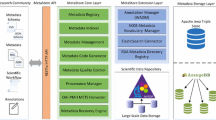Abstract
Research projects in earthquake engineering yield a very large amount of complex data from experiments and computer simulations. Understanding and exchanging these complicated and voluminous data sets prompted the development of metadata models that document the processes of data generation, and facilitate the collaboration and exchange of information between researchers. The present metadata model was designed to document and exchange a large number of large data files in earthquake engineering, but is applicable to other fields of engineering and science. The model was conceived based on a series of former data models, which were unduly complicated and limited to few types of experiments. Simpler than its predecessors, the present metadata model applies to all kinds of earthquake engineering experiments. It was developed in the object-oriented framework using Protégé. Its applications are illustrated with examples from centrifuge experiments.
Similar content being viewed by others
References
VELACS. Centrifuge and laboratory data sets of the NSF collaborative project verification of liquefaction analysis using centrifuge studies. University of Southern California, Civil Engineering Department, Los Angeles, California, 1997. http://gees.usc.edu/ROSRINE
ROSRINE. Resolution of site response issues from the Northridge earthquake. University of Southern California, Civil Engineering Department, Los Angeles California, 2001. http://geoinfo.usc.edu/rosrine/
COSMOS. COSMOS geotechnical data model, version 0.5. Civil Engineering Department, University of Southern California, Los Angeles, California, 2003.
CUREE. CUREE-caltech wood frame project. Consortium of Universities for Research in Earthquake Engineering (CUREE), 2002. http://www.curee.org/projects/woodframe/
Bardet J P, Peng J, Law K, Swift J. Overview of the NEES data/metadata model. In: Proceedings of the 13th World Conference in Earthquake Engineering, Vancouver, 2004, paper 4001
Peng J, Law K. Reference NEESgrid data model. NCSA Technical Report 2004-40, 2004
Swift J, Eng J, Bardet J P, Liu F, Mokarram N, Pekcan G. Using the NEES reference data model and the NEES metadata browser for centrifuge experiments version 1.1. Report of Civil Engineering Department, University of Southern California, Los Angeles
Rumbaugh J, Blaha M, Premerlani W, Eddy F, Lorensen W. Object-Oriented Modeling and Design. Englewood Cliffs: Prentice Hall, 1991
Arlow J, Neustadt I. UML and the Unified Process: Practical Object-Oriented Analysis and Design. Boston: Addison-Wesley, 2001
Booch G. Object-Oriented Analysis and Design with Applications. 2nd ed. Boston: Addison-Wesley, 1993
Gamma E, Helm R, Johnson R, Vlissides J. Design Patterns: Elements of Reusable Object Oriented Software. Boston: Addison-Wesley, 1995
Meyer B. Object-Oriented Software Construction. 2nd ed. Englewood Cliffs: Prentice Hall, 1997
Jacobsen I. Object-Oriented Software Engineering: A Use Case-Driven Approach. Boston: Addison-Wesley, 1994
Duineveld A J. Stoter R, Weiden M R. Kenepa B, Benjamins V R. WonderTools? A comparative study of ontological engineering tools. International Journal of Human-Computer Studies, 2000, 52(6): 1111–1133
Protégé. The Protégé project. Stanford University. 2004. http://protege.stanford.edu
Gennari J, Musen M A, Fergerson R W, Grosso W E, Crubézy M, Eriksson H, Noy N F, Tu S W. The Evolution of Protégé: An environment for knowledge-based systems development. Technical Report SMI-2002-0943, 2002
The American Heritage Dictionary of the English Language. 4th ed. Orlando: Houghton Mifflin Company, 2000
Zand A G, Bardet J P. Protégé plug-in extensions for NEES metadata model. Report, Civil Engineering Department, University of Southern California, Los Angeles, 2004
Bardet J P. Liu F, Mokarram N. Application of the NEES metadata model to the miniMOST experiment. Report, Civil Engineering Department, University of Southern California, Los Angeles, 2004
Bardet J P, Liu F, Mokarram N. Documentation, reporting and exchange of centrifuge test results using a metadata Model. Report, Civil Engineering Department, University of Southern California, Los Angeles, 2004
Bardet J P, Liu F, Mokarram N. Report and exchange of NEES data sets using metadata model. Report, Civil Engineering Department, University of Southern California, Los Angeles, 2004
Author information
Authors and Affiliations
Corresponding author
Rights and permissions
About this article
Cite this article
Bardet, JP., Liu, F. & Mokarram, N. A metadata model for collaborative experiments and simulations in earthquake engineering. Front. Archit. Civ. Eng. China 4, 133–153 (2010). https://doi.org/10.1007/s11709-010-0036-z
Received:
Accepted:
Published:
Issue Date:
DOI: https://doi.org/10.1007/s11709-010-0036-z




